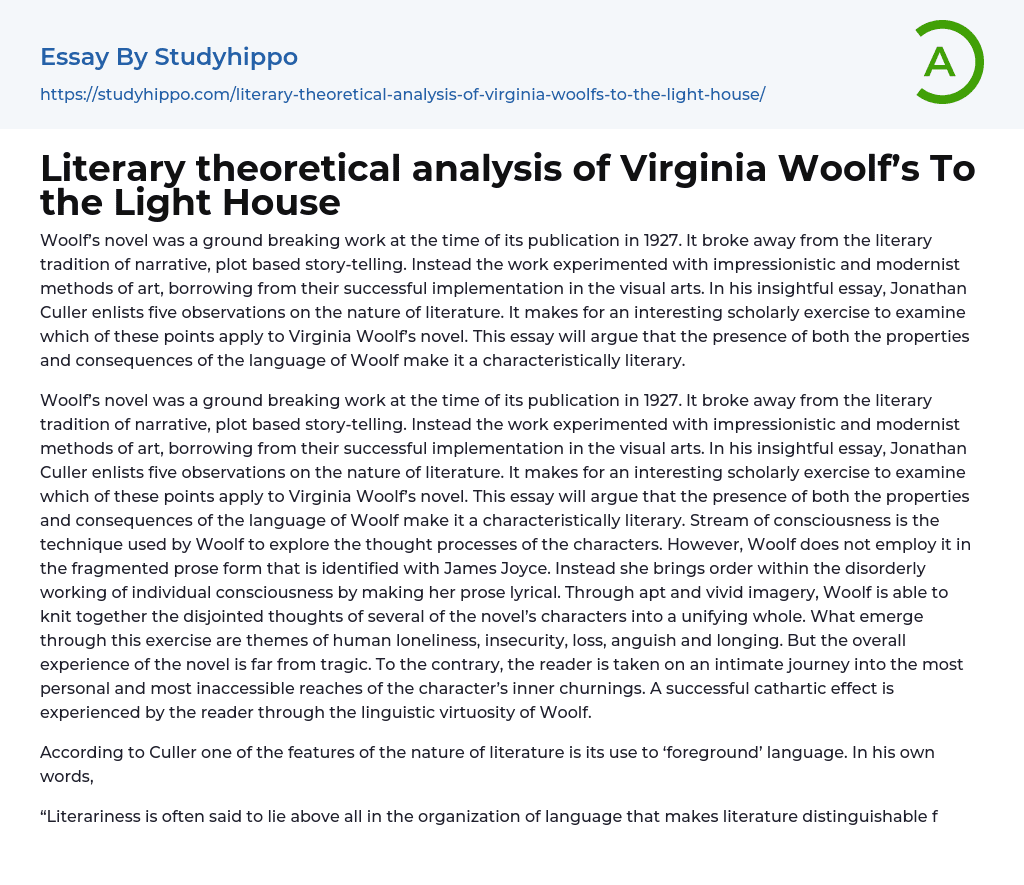

Literary theoretical analysis of Virginia Woolf’s To the Light House Essay Example
Woolf’s novel, published in 1927, was a groundbreaking work that defied traditional narrative and plot-based storytelling. Instead, it embraced impressionistic and modernist approaches borrowed from the visual arts. In his essay, Jonathan Culler examines five aspects of literature, providing an interesting opportunity to analyze their relevance to Woolf’s novel. This essay contends that Woolf’s novel exhibits both the attributes and outcomes of literary language, making it distinctly literary in nature.
Woolf’s 1927 novel was groundbreaking as it departed from traditional narrative storytelling. Instead, it experimented with impressionistic and modernist artistic methods, drawing inspiration from the visual arts. In an insightful essay, Jonathan Culler presents five observations about literature. It is interesting to examine which of these observations apply to Woolf’s novel. This essay argues that Woolf's novel possesses both the characteristics and consequences of literary language, making it
...distinctively literary. Woolf utilizes the stream of consciousness technique to delve into the characters' thought processes. However, she approaches it differently than James Joyce, avoiding fragmented prose by infusing her writing with lyrical qualities. Through vivid and appropriate imagery, Woolf weaves together the disjointed thoughts of various characters into a cohesive whole. This exploration reveals themes of human loneliness, insecurity, loss, anguish, and yearning. Yet, despite these themes, the novel's overall experience is not tragic. On the contrary, it provides an intimate journey into the deeply personal and inaccessible depths of the characters' inner reflections.The linguistic virtuosity of Woolf delivers a successful cathartic effect to the reader.
According to Culler, literature has the ability to "foreground" language. This means that language is highlighted and emphasized in literature.
"Literariness is often defined by the way language is organized in literature, distinguishing
it from language used for other purposes. Literature puts language itself in the spotlight, making it appear unfamiliar and noticeable - as if saying, 'Look, I'm language!' This ensures that readers are constantly aware that they are engaging with language that has been crafted in unique ways." (p.28)
Woolf's prose style is a prime example of achieving foregrounding. She accomplishes this through various stylistic and thematic features. By using lyrical exposition of inner monologues, Woolf contemplates profound subjects such as the meaning of life. The use of language, specifically English, as the sole medium of communication, further highlights its significance. Additionally, the novel form itself becomes foregrounded, even if unintentionally by the author. An illustration of this is the stream of consciousness, which solely works within the novel format and sets it apart as distinctly literary.
"What is the meaning of life? It was a simple question that as time passed, seemed to become more burdensome. The profound revelation never arrived, maybe it never would. Rather, there were frequent small wonders, sudden bursts of enlightenment that occurred unexpectedly in the midst of uncertainty; this was one such instance." (p.69)
In terms of the relationship between properties and consequences of the text, both can be identified within the passage. The passage stands out as a philosophical monologue due to its use of questioning and thoughtful language. As a result, the consequence is the author's intention of engaging in philosophical contemplation. Additionally, throughout the novel, there is an emphasis on the author's personality, in addition to the known inclusion of biographical elements. Woolf is interpreting her own fleeting consciousness as she carefully crafts sentences.
Culler characterizes the second aspect of literature
in the following manner:
Literature involves the intricate connection of various elements and components within a text. Unlike receiving a letter requesting a donation for a good cause, where the sound and meaning may not align, literature contains relations that either strengthen or contrast different linguistic aspects. These relations can be observed between sound and meaning, as well as grammatical structure and thematic patterns. For example, a rhyme, such as 'suppose/knows', establishes a connection between the meanings of the two words, prompting us to question if 'knowing' is the opposite of 'supposing' (p.29).
In summary, for a text to be classified as Literature, it is not enough to merely convey certain arguments and points of views. Coherence, logic, and sense are essential qualities, but form is equally important in literature as it is primarily an art. A lucidly explained point of view will not be effective without the accompaniments of rhyme, rhythm, tone, and structure. What distinguishes literature from other written texts is its ability to endure and remain relevant across generations and centuries. To achieve this, all elements and components of the text must resonate with each other. This explains why To the Lighthouse has maintained its lasting relevance.
- Cleaning essays
- Book Summary essays
- Metaphor essays
- Reader essays
- Rhyme essays
- Literary devices essays
- Villain essays
- Books essays
- Genre essays
- Literary Criticism essays
- Writer essays
- Protagonist essays
- Simile essays
- Poem essays
- Book Report essays
- Book Review essays
- Greek Mythology essays
- Plot essays
- Tragic Hero essays
- Coming of Age essays
- Play essays
- Rhetoric essays
- Rhetorical Question essays
- Translation essays
- Understanding essays
- Reason essays
- Character essays
- Letter essays
- American Literature essays
- Literature Review essays
- Utopia essays
- Poetry Analysis essays
- Dante's Inferno essays
- Between The World and Me essays
- Incidents in The Life of a Slave Girl essays
- Flowers for Algernon essays
- Myth essays
- Everyday Use essays
- Boo Radley essays
- Genesis essays
- Richard iii essays
- Alice in Wonderland essays
- On the road essays
- Ozymandias essays
- The Nightingale essays
- Holden Caulfield essays
- Animal Farm essays
- 1984 essays
- A Hanging essays
- Shooting An Elephant essays



